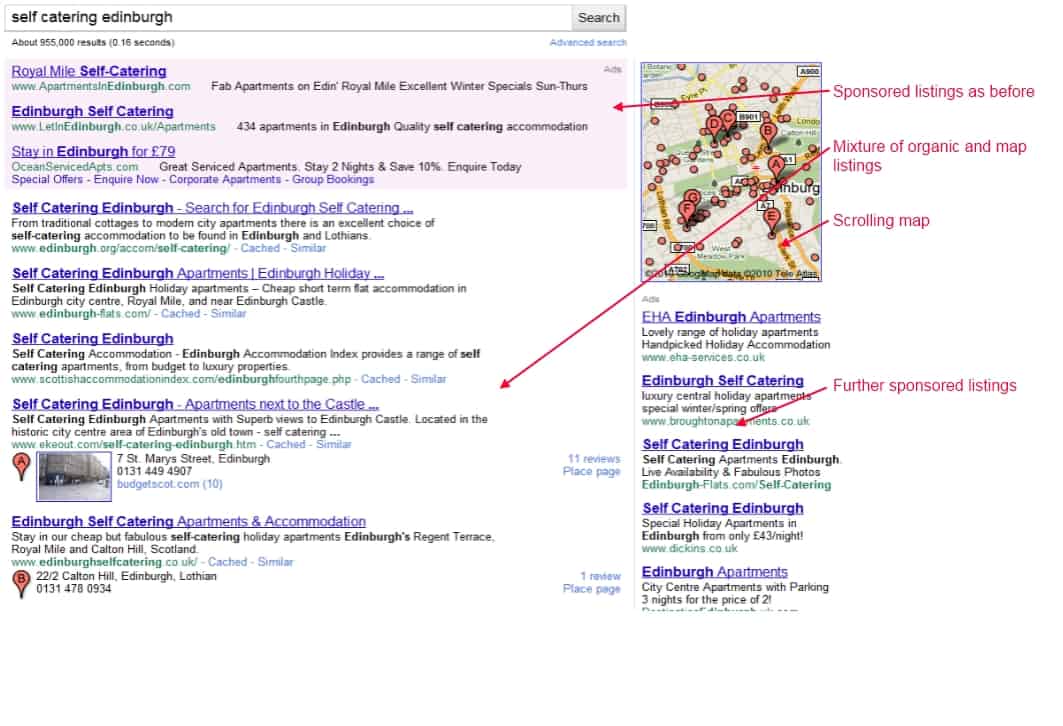Google rolled out Instant and it was the talk of the town.
Yet last week Google made one of the most significant changes it has ever made and it has hardly created a ripple beyond the search engine optimisation community. It’s very big news for anybody wanting to rank for local search phrases (e.g. “Water Coolers Edinburgh” rather than “Water Coolers”)
The early reports put me into a flat spin until past experience told me that it rarely pays to react too quickly to a Google change. This is especially true when the reported changes simply don’t feel right from a user’s persepctive. Since then it has become clear that initial reports over-exaggerated the impact of the change but this is still an important move by Google and unlike many changes to Google, does actually require some changes to the way SEO is approached. Indeed we’ve got a new local algorithm to think about which I discuss below.
The Layout Change
For a good while Google’s map listings have been appearing in the main search engine result pages (SERPs). Before the change you would get a map in the main lisitng with a number of mini-listings for each of the places Google thought relevant. Now the map has moved and the mini listings have become even more prominent than the usual main listings.
The new layout is shown below, highlights include:
- The top 3 results continue to be sponsored listings (Google AdWords pay-per-click)
- The main results at the top of the page are now a hybrid mixture of ‘traditional’ organic results & map listings. We are seeing lot’s of variations in layout, some dominated by places listings, others much less so.
- The new map listings should experience better click rates due to the visual “pull” of the image and marker that is now included
- Reviews are much more prominent, so this is something we all need to put greater emphasis on
- The Google map is now shown on the top right hand side of the screen (this is likely to mean a reduction in the number of clicks on sponsored listings that normally occupied this space). Furthermore, the map actually scrolls with the screen, covering the PPC ads as it scrolls and making them unclickable.
- Further organic listings are shown below (and sometimes throughout) the map listings
- All further sponsored listings are shown below the map on the right hand side (we are already seeing increased competition for top 3 spots following this change)
A New Algorithm
All the place listings and the normal listings are now intermingled. This could have been achieved largely as a layout change but…
The order the places listings appear in the main results is different to the order you see if you do a search on Google Maps (which is still using the old rather flawed maps/places algorithm). This tells me that Google has added some additional means for deciding how to order map results.
One approach could have been to simply use the usual organic algorithm (i.e. simply continue to rank as before) and then simply change the organic listing to a places one if appropriate. They haven’t done this however as you can find many places results that weren’t in the main listings before. Further this approach would not have allowed Google to include companies who have no website but do have a places listing.
They must therefore have created a hybrid algorithm of sorts in addition to the “blend” type algorithm. They’ve come up with a way to compare apples and pears.
Pears (the “normal” listings) were ranked based on website content, links and other signals whilst the apples (place listings) were ranked on aspects such as reviews, citations and the quality of the content on the Google Places page. It seems that local queries are now being ranked based on a combination of these elements.
The question I continue to muse over is why display the places listings in “packs” (as noted by Andrew Shotland) – surely it would make sense to view each entity you want to list seperately. I can only assume that this is part of the solution to being able to rank entities with no websites? Packs also worry me for another reason. I suspect it may lead to sudden movement in ranks for companies as Google simply calculate that a query deserves a different “pack” arrangement.
A Quality Improvement… But Who’s in Trouble?
In most aspects, these changes are good news for the user. For companies looking to get traffic from these phrases, the news is mixed.
For a couple of years it has been relatively easy to achieve good rankings in the map listings. This has been a god-send for sites that are unfit for purpose. That party may not yet be over but it is certainly starting to thin out. Now that you need to consider traditional organic factors as well, your website and online marketing become important. That means your SEO consultant has no choice to be all over your site as well as your reviews etc.
Other losers will be those who don’t have a local presence but are looking to target local searches. If you are an agency or directory type, you do need to re-think things; there’s writing on the wall, though it isn’t immediate death as some have claimed.
If you’ve been focusing on more rounded SEO (good design, content code & online marketing) and you are a local, then chances are your quids in.

